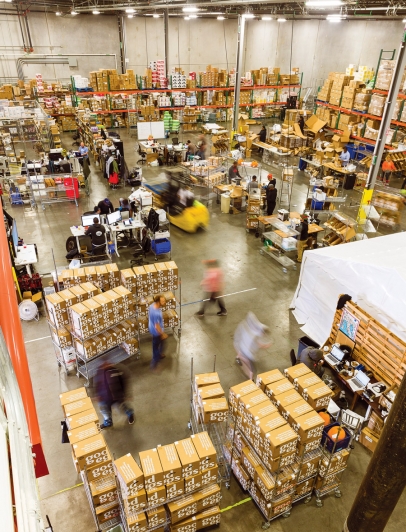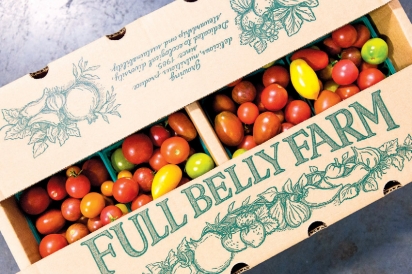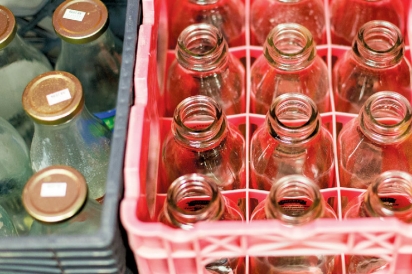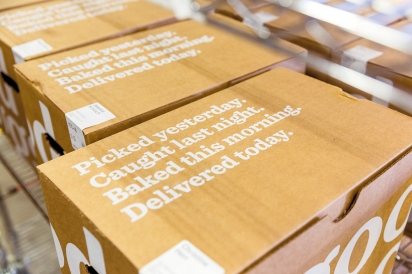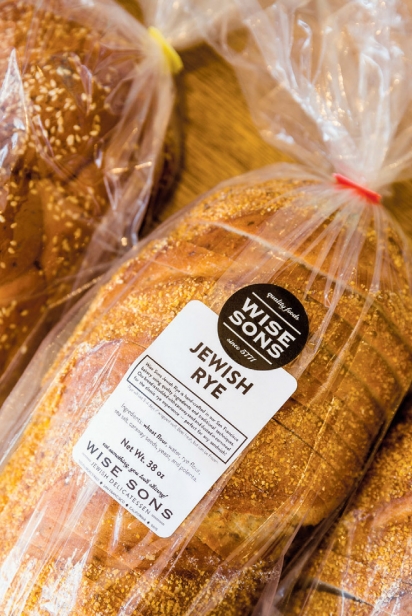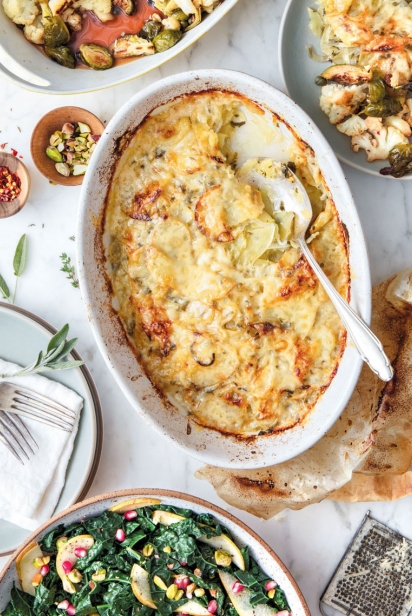Good Eggs
DELIVERING A PEEK AT THE FUTURE OF FOOD
There are few things more widely available than food. From supermarkets and corner stores to gas stations, farmers’ markets and even your own doorstep, grocery goods are omnipresent. Add in the “always-open” insistence of the Internet, and the sourcing of food feels more “on demand” than ever before.
As evidenced by the recent purchase of Whole Foods by online retailing giant Amazon, our entire food system is in the midst of a sea change. The Bay Area, a hub of both food culture and technological innovation, is driving much of that change. One of the businesses at the forefront of these changes is the grocery and meal kit delivery company Good Eggs, but, as the tag line emblazoned on their fleet of delivery vehicles reads: “… not like you think.” This innovative, techdriven grocer is also on a mission to support the local food system.
HIGH-TECH DELIVERY FOR LOCAL FOOD
Yeah, you have likely heard that before. But Good Eggs, which was founded in San Francisco’s Mission District in 2011 “with the mission to help grow and sustain local food systems, worldwide,” walks the talk every day. Owned by sustainability-driven private investors, Good Eggs consciously built their platform to give small producers a web presence, an online marketplace that they do not have to manage, or market, themselves. And everything that goes on inside of Good Eggs’ production and distribution facility is focused on simplifying and shortening the supply chain from producer to consumer.
San Rafael resident and Good Eggs CEO Bentley Hall calls it “building a backbone for the local food system.” According to the company’s website, 80% of the products offered by Good Eggs come from local producers (defined for Good Eggs as within 250 miles), whereas the average chain grocery or big-box store offers less than 1% local products.
A full-shop grocer, Good Eggs offers everything from flowers for the dinner table to almost-ready-to-eat meal kits, as well as beer, wine and, as of this fall, spirits. To keep their own shelves stocked, Good Eggs sources fresh, locally grown and produced goods from over 600 suppliers. Daily deliveries arrive from ranchers including Marin County’s Stemple Creek, micro-regional produce aggregators like FEED Sonoma, and Siren Fish Co., a community-supported seafood supplier based in Bodega Bay.
To receive merchandise and turn it around for shipping to the customer within 24–48 hours, Good Eggs developed proprietary software and hired an A+ team. “We have packers packing 10 orders simultaneously,” said Dani Fisher, Good Eggs’ head of marketing. “They pick and pack together and use our system to ensure heavier items are on the bottom and not crushing the eggs.” In an industry where the average product turnover is 12 days, watching the Good Eggs pick-pack process is avant-garde. Staff roll tiered racks lined with shipping boxes through Good Eggs’ many aisles, scanning items as they go. “There are only two touch points for every product,” said Hall: “when it arrives at the receiving bay and when it is packed for shipping to the customer.”
It’s a supply chain wonk’s dream come true. Why?
Think for a moment about how most food moves onto a store’s shelf. Manufacturers develop products or have a co-packer produce them. That’s at least a few days where ingredients are hanging out, waiting to be put into assembly. The finished product is then shipped to a warehouse that ships it to a distributor, who ships to a store. The store then places it on a shelf where the customer sees the product for the first time.
“That’s a lot of touch points,” said Hall, who notes that this standardized system can mean produce that is quite aged by the time a customer first encounters it. Many fruits and vegetables are put through some sort of preservation process to ensure they can endure an average of 12 days in transition from harvest to shelf. Good Eggs condenses the process. “We are purpose-built to store and move products more efficiently,” said Hall.
What difference does this make for consumers, you might ask? Well, only the difference between the taste of a 12-day-old peach versus one harvested around 24 hours ago. Good Eggs customers look at the company as a next-gen farmers’ market. Major bonus: That freshness is delivered to your door. And they also deliver dry goods like Rancho Llano Seco’s dried heirloom beans, Baia and Community Grains pastas, Oaktown Spice Shop’s spices and Rustic Bakery and Urban Remedy crackers that your farmers’ market doesn’t carry.
NOT JUST ANY FOOD
Number one on the list of Good Eggs Food Standards published on the company’s website is that everything that goes out the door should taste “amazing.” Next is that the food should be locally sourced whenever possible. Producers must provide 100% supply chain transparency, down to the tiniest ingredient in a meal kit. “No shady ingredients” speaks to chemical additives. The meats they offer are sourced from producers who are committed to giving their animals a good life. Fair treatment of labor at supplier companies is also on the list.
Producers that meet these high standards are not always easy to find, and to keep up with growing demand, Good Eggs is also committed to nurturing the growth of the local producer base. Jamie Nessel, Good Eggs’ vice president of buying and merchandising, came to Good Eggs after 10 years developing supplier partnerships at Whole Foods. Nessel recently began working with Kitchen Table Advisors, an Oakland-based investment group dedicated to mentoring sustainable agriculture businesses with business and financial advising.
“We do want to fill in volume with small producers and continue to support them. We are always producer-focused,” said Nessel.
Dana Peck is CEO of Render, a new Healdsburg-based company that takes great food ideas born in restaurant kitchens and produces them for mass market retail, including a puffed quinoa snack created by chefs Stuart Brioza and Nicole Krasinski of San Francisco’s State Bird Provisions. Peck confirmed Good Eggs’ efforts in this area.
“We have loved working with Good Eggs through every step of the process, from discussing our shared brand values to finding ways to spread the word about our brand. In an industry where retailers tend to shy away from new brands, Good Eggs embraced us and partnered with us to get State Bird Seed out into the world.”
FROM GROCERIES TO MEAL KITS
The launch last April of Good Eggs’ Meal Kits program heightened the necessity of increasing the volume, and breadth, of suppliers in order for the company to remain true to its mission on sourcing for the new venture.
What began as a lunch program for Good Eggs staff evolved into a chef-led meal kit program designed to get dinner on the table quickly for its customers, said Nessel. With time management as their guiding principle, Nessel and Good Eggs Culinary Director Jimmy Monaco designed three styles of meal kits. The first is a “mostly reheat” meal. That might be beef barbacoa tacos, the beef sourced from Oak Ridge Angus, never fed corn and finished on Bear Republic Brewing’s spent grains. Monaco and his team do the heavy lift: the beef ’s slow braise, “compacting the amount of work at home from five hours to five minutes,” said Nessel.
The second style of meal kit is the “20-minute cook time,” which is mostly assembly but does require some light cooking. For fall, this category included a kit titled “Fried-Rice Farro” that arrived with seasonal vegetables, such as kale and butternut squash, already cooked, and the pre-prepped farro needed only a quick swirl in the pan. As fall transitions to winter, look for seasonal and holiday meal kits such as trout with cauliflower and salsa verde and a cassoulet loaded with sausage, duck confit and beans. These may fall into a third meal kit style, the “40-minute meal.” These are protein-based and usually require a bit of oven roasting.
The culinary team also recently launched a special meal kit in partnership with the Southern Marin Mothers Club, called Meals for Moms, as well as bento-box-style lunch kits for kids. A kids’ dinner kit, developed in collaboration with the Bay Area Discovery Museum, will come to market in January.
Kit offerings also include beverage and entertaining options. A sangria kit, popular during summer and autumn, will transition to cocktail kits for fall and winter holidays. Cheese kits include local favorites Teleeka from Tomales Farmstead Creamery and Bellwether Farms’ Carmody.
Jared Shoupe, Good Eggs’ specialty food category manager, launched the company’s spirits program in September. Sourcing wine was easy, as “so many producers are in the area and share our values,” but sourcing spirits proved more challenging for Good Eggs’ business model, said Shoupe. You’ll find lots of Alameda’s St. George Spirits on their shelves, as well as rhum agricole from Marin-based Batiste.
“Bourbon was hard, as almost all corn grown in the U.S. is GMO [genetically modified],” said Shoupe, a reality that forced them to source outside the local area. For imports, “we only work with Fair Trade producers and we will not work with producers who won’t provide us supply chain transparency,” added Nessel.
Shoupe is currently working with Thad Volger at Bar Agricole in San Francisco to develop a cocktail kit.
GIVING THE PEOPLE WHAT THEY WANT
What about those customers who still demand a strawberry in December? “How do you convince people to only eat persimmons?” joked Ben Hartman, Good Eggs produce category manager. Hartman recently began working with Harvest Santa Barbara, a distributor that shares Good Eggs’ vision of a sustainable food system, to extend the grocer’s berry season.
Hartman also explained Good Eggs’ Up For Grabs program that reduces food waste. Produce that is past its prime, or bread or dry goods that are past their sell-by date, are used by the Good Eggs culinary team for staff lunch, and frequently offered through the store as special smoothie or juicing boxes.
Good Eggs customer service also extends far past the point of sale. “Our drivers are on staff [not part of the gig economy] and care about the customers and the brand,” said Alyssa Chandler, customer service manager. “If we find out that you’re having a baby (maybe you mention it to the driver), we’ll send you a gift for when you get home from the hospital. One of our drivers helped a customer rescue a dog that had gotten loose. We know things won’t always be perfect. The important thing is to make it right, and quickly,” said Chandler.
BEYOND THE FOOD
Many consumers rightfully object to the wasteful packaging that seems to be an inevitable component of most meal kit services. Good Eggs says that it is continually looking for ways to reduce its packaging impact. As an example, if a meal kit recipe calls for a tablespoon of olive oil, it will not ship you a plastic and plastic-lidded container with a tablespoon of olive oil. “We assume you have that at home,” said Nessel. “And if not, you can buy it and have it sent along with your meal kit.”
Good Eggs also works closely with its producer partners to minimize waste along the entire supply chain. Your Good Eggs driver will pick up those empty Straus Family Creamery glass bottles at your next delivery and the company will credit you the $2 bottle deposit. The bottles are returned to Straus, which sanitizes them for reuse. Straus reports the bottles are reused on average four to six times before they are eventually recycled and are made from 50% recycled glass. Instacart, the national service that delivers groceries from a number of local retail grocery stores including Whole Foods, Mollie Stone’s and Safeway, does not accept returns of Straus bottles.
WHERE TO NEXT?
In 2015, Good Eggs scaled back its distribution area from multiple markets across the U.S. to focus solely on the Bay Area. Hall came in as CEO that summer to help the company shift from “growth at all costs to growing with purpose,” as he put it. For the past two years, Hall has worked to strengthen the company’s foundation—building out a complete product assortment, improving processes to enable same-day deliveries, launching meal kits—with a focus on serving more customers in the Bay Area.
“We will expand to other West Coast markets at some point, but it will be slow and deliberate,” Hall said. That could be as soon as next summer, with Hall admitting only to “plans to expand into a larger, West Coast market.”
One thing is for sure: Many customers are no longer only thinking about where their food comes from. The entire purchasing experience, especially the time required to stock one’s larder, matters.
Robin Sloan, the Berkeley-based author of works including Sourdough (MCD, 2017) and a Good Eggs customer since 2013, summed up the Good Eggs experience this way: “Good Eggs is not a convenience anymore. It feels as natural as carrying a bag of groceries home.” GoodEggs.com


